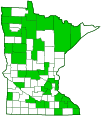night-flowering catchfly
(Silene noctiflora)
Conservation • Description • Habitat • Ecology • Use • Distribution • Taxonomy
Conservation Status |
|
|||||||
| IUCN Red List | not listed |
|||||||
| NatureServe | NNA - Not applicable SNA - Not applicable |
|||||||
| Minnesota | not listed |
|||||||
Description |
||
Night-flowering catchfly is a 8″ to 32″ tall, erect, annual forb that rises from a slender taproot. When young the plant forms a basal rosette of leaves. Later it sends up flowering stems. The stems are erect and branched on the upper part. They are densely hairy and are covered with sticky glandular hairs near the top. There are up to 10 pairs of leaves on the stem. Basal leaves are broad, inversely lance-shaped with the attachment at the narrow end, 2⅓″ to 4¾″ long, less than ¾″ to 1¾″ wide, densely hairy, and on leaf stalks. Stem leaves are narrower and opposite, with up to 10 opposite pairs of leaves on the stem. They are lance-shaped to broadly elliptic, up to 4¾″ long and 1½″ wide, becoming progressively smaller as they ascend the stem. They taper gradually to a pointed tip with straight sides along the tip, and are attached to the stem without a leaf stalk. They are conspicuously veined and densely hairy on the upper and lower surfaces, the upper leaves covered with sticky, glandular hairs. The margins are untoothed. The inflorescence is open, loosely-branched cluster of 3 to 15 flowers. Each cluster is subtended by a pair of ⅜″ to 2″ long, leaf-like, narrowly lance-shaped bracts. Flowers are ¾″ to 1″ wide when fully open on a stalk that is longer than the calyx. They have both male and female reproductive organs (perfect). They are fragrant. They open in the evening and are pollinated by moths. The sepals are fused at the base into a tube (calyx) terminating in 5 short, erect lobes. The calyx is ⅔″ to 1⅛″ long and about ⅛″ wide when in flower, swelling to ⅜″ wide when in fruit. It is narrowed at both ends and constricted at the base. It has 10 major veins that are raised on the surface (prominent), forming ridges, with a network of veins between them. The 5 petals are white, often tinged pink, and yellowish underneath. They are horizontally spreading. They have 2 deep, narrow lobes, and a stalk-like narrow base (claw). There are 10 stamens that are shorter than the petals and 3 styles, also shorter than the petals. The fruit is a 3-chambered capsule the same size as or slightly longer than the calyx, with 6 teeth at the top that are bent backward. |
||
Height |
||
8″ to 32″ |
||
Flower Color |
||
White, often tinged pink |
||
Similar Species |
||
White campion (Silene latifolia ssp. alba) has unisexual flowers with male and female flowers on separate plants. The flowers have just 5 or 6 styles. The fruit has 5 2-lobed teeth at the top that are upright, not bent backward. |
||
Habitat |
||
Railroads, disturbed sites. Partial shade. |
||
Ecology |
||
Flowering |
||
July to September |
||
Pests and Diseases |
||
|
||
Use |
||
|
||
Distribution |
||||
|
Sources |
|||
| 2/22/2023 | ||||
Nativity |
||||
Native to Asia and Europe. Introduced and naturalized in North America. |
||||
Occurrence |
||||
|
||||
Taxonomy |
|||
| Kingdom | Plantae (Plants) | ||
| Division | Tracheophyta (Vascular Plants) | ||
| Subdivision | Spermatophytina (Seed Plants) | ||
| Class | Magnoliopsida (Dicots) | ||
| Subclass | Caryophyllidae | ||
| Superorder | Caryophyllanae | ||
Order |
Caryophyllales (Pinks, Cactuses, and Allies) | ||
Family |
Caryophyllaceae (Pink) | ||
| Subfamily | Caryophylloideae | ||
| Tribe | Sileneae | ||
Genus |
Silene (catchflies) | ||
| Subgenus | Behenantha | ||
| Section | Elisanthe | ||
Subordinate Taxa |
|||
|
|||
Synonyms |
|||
Elisanthe noctiflora Melandrium noctiflorum |
|||
Common Names |
|||
night-flowering catchfly nightflowering silene sticky cockle |
|||
Glossary
Bract
Modified leaf at the base of a flower stalk, flower cluster, or inflorescence.
Calyx
The flower cup. May be the group of outer floral leaves (sepals) collectively, or a tube with lobes.
Claw
A stalk-like narrowed base of some petals and sepals.
Glandular hairs
Hairs spread over aerial vegetation that secrete essential oils. The oils act to protect against herbivores and pathogens or, when on a flower part, attract pollinators. The hairs have a sticky or oily feel.
Visitor Photos |
|||||
Share your photo of this plant. |
|||||
| This button not working for you? Simply email us at info@MinnesotaSeasons.com. Attach one or more photos and, if you like, a caption. |
|||||
|
|||||
MinnesotaSeasons.com Photos |
|||||
|
|||||

Slideshows |
||

Visitor Videos |
|||
Share your video of this plant. |
|||
| This button not working for you? Simply email us at info@MinnesotaSeasons.com. Attach a video, a YouTube link, or a cloud storage link. |
|||
Other Videos |
|||

Visitor Sightings |
|||||
Report a sighting of this plant. |
|||||
| This button not working for you? Simply email us at info@MinnesotaSeasons.com. Be sure to include a location. |
|||||
|
|||||
MinnesotaSeasons.com Sightings |
|||||

|
Created: Last Updated: © MinnesotaSeasons.com. All rights reserved. |
